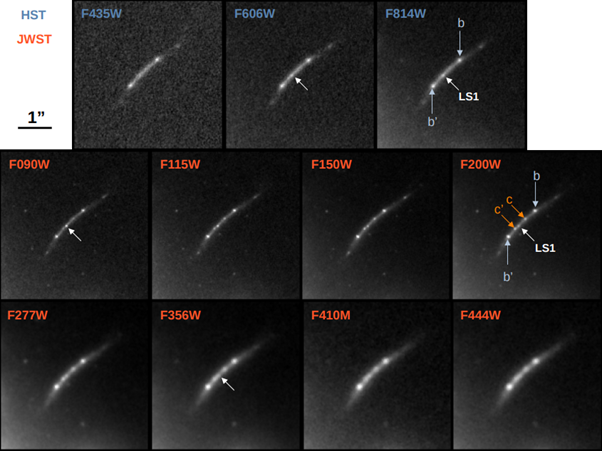Astronomers have observed a giant star system, probably composed of a pair of stars, that is far too bright for the distance over which we see it. According to a yet-to-be-published paper, the star is being gravitationally lensed by something massive between us and it. However, with no suitably placed galaxies to do the job, the light could be being bent by a patch of dark matter, possibly around a small star cluster. If so, identifying this phenomenon might be the key to explaining what dark matter actually is.
One of General Relativity’s consequences is that gravity bends light. Strong gravitational fields can therefore act like lenses, distorting the images we see, and if positioned correctly making them far brighter. We witness this in action within our galaxy, when stars pass in front of each other, and can use smaller brightening to identify the presence of planets we couldn’t detect otherwise. On a larger scale, the only way we can see the most distant objects within our capacity is with the assistance of gravitational lenses created by closer galaxies.
When the star nicknamed Icarus was detected in 2018, it opened up an exciting new opportunity. Here was an immensely bright star, but nevertheless one at such a great distance we would not normally be able to make it out individually with even our most powerful instruments. The presence of the galaxy cluster MACS J1149 allows astronomers to study it, the first time this has been possible for an individual star at such a great distance.
Astronomers from 20 scientific institutions are hot on the heels of an even more distant star system they think is also being lensed. In this case, they think a double lensing is going on, both by the galaxy cluster between us and the star in question, MACS0416, and something more exotic.
A previous star with somewhat similar characteristics was nicknamed Godzilla for its monstrous brightness by the same authors. The team has decided to keep up the theme, calling the class of stars these two belong to kaiju stars, after the Japanese film monsters, and naming this one Mothra.
Scientists could hardly be expected to be satisfied with just one example of something so amazing. A study comparing JWST data with archival Hubble images turned up 12 very distant stars only visible because of lensing by closer galaxies, but only one was considered to resemble Godzilla sufficiently to earn the kaiju designation.

Hubble (blue) and JWST (red) images of LS1, the image of the galaxy that contains Mothra with different filters
Both Godzilla and Mothra are in galaxies with redshifts of more than z=2, placing them more than 15 billion light-years from Earth. As Mothra’s discoverers explain; “The monster nature of Godzilla comes from the combination of three factors: i) it is extremely luminous and likely undergoing a major outburst […] ii) it is close to the caustic of a powerful gravitational lens; iii) it is further magnified by a relatively large (yet invisible) substructure.”
Mothra’s official name is EMO J041608.8−240358, EMO here standing for Extremely Magnified Object, rather than signifying its taste in music and clothes.
“The similarity between the source discussed in this paper and Godzilla lies in the fact that both are extremely luminous stars, they are both believed to be intrinsic variables, and both are highly magnified by a dark substructure that is not directly detected and with a mass in the range of dwarf galaxies,” the authors write.
Each of these aspects makes Mothra interesting, but it’s the dark substructure that might really matter. Astronomers see overwhelming evidence for the presence of dark matter in the universe, but have been frustrated in their efforts to learn its nature.
The authors consider several scenarios for the object doing the lensing, but think the most likely is what they call a millilens with a mass between 10,000 and 2,500,000 times greater than the Sun. Any star or group of stars that massive would be visible. Consequently, the authors think it is either a black hole or a concentration of dark matter, possibly around a globular cluster too faint to see. In the latter case, further observations may help us decide between competing models of dark matter’s form.

One of the models for Mothra’s and the objects gravitationally lensing it
Mothra itself is thought to be two stars, a yellow supergiant with a mass around 15 times that of the Sun overshadowed by an extremely hot star more than twice as bright. The hotter star is varying considerably in the red part of the spectrum.
The paper has been submitted to Astronomy & Astrophysics and a preprint is available on ArXiv.org
[H/T ScienceAlert]
Source Link: Ridiculously Bright "Kaiju" Star Named Mothra Could Be Clue To Explain Dark Matter